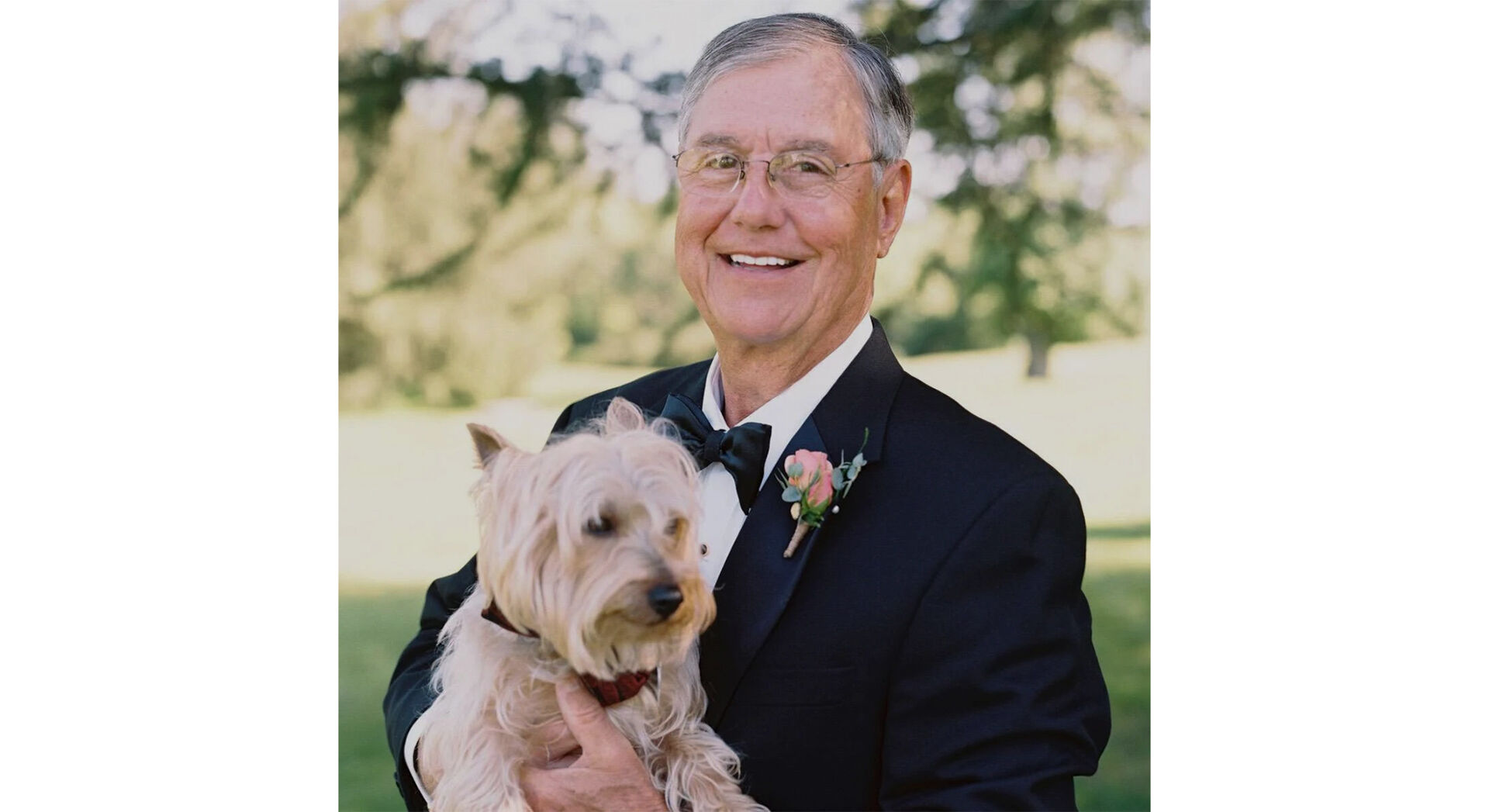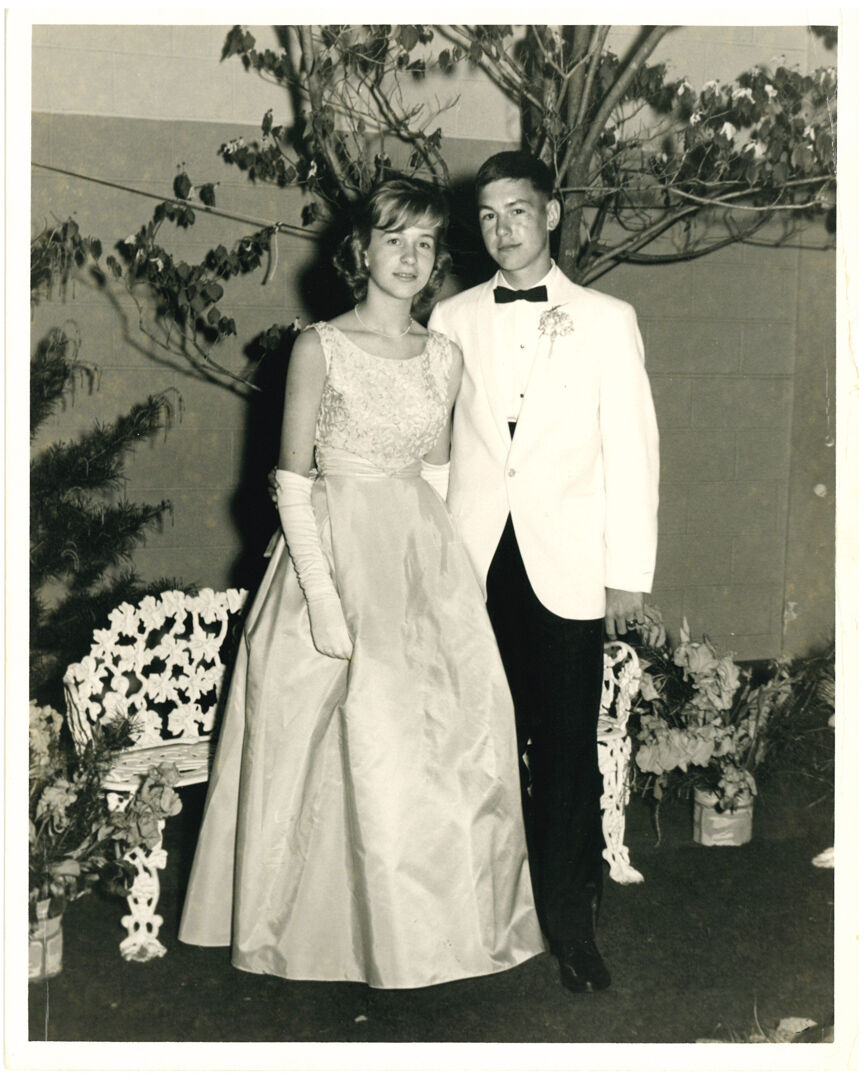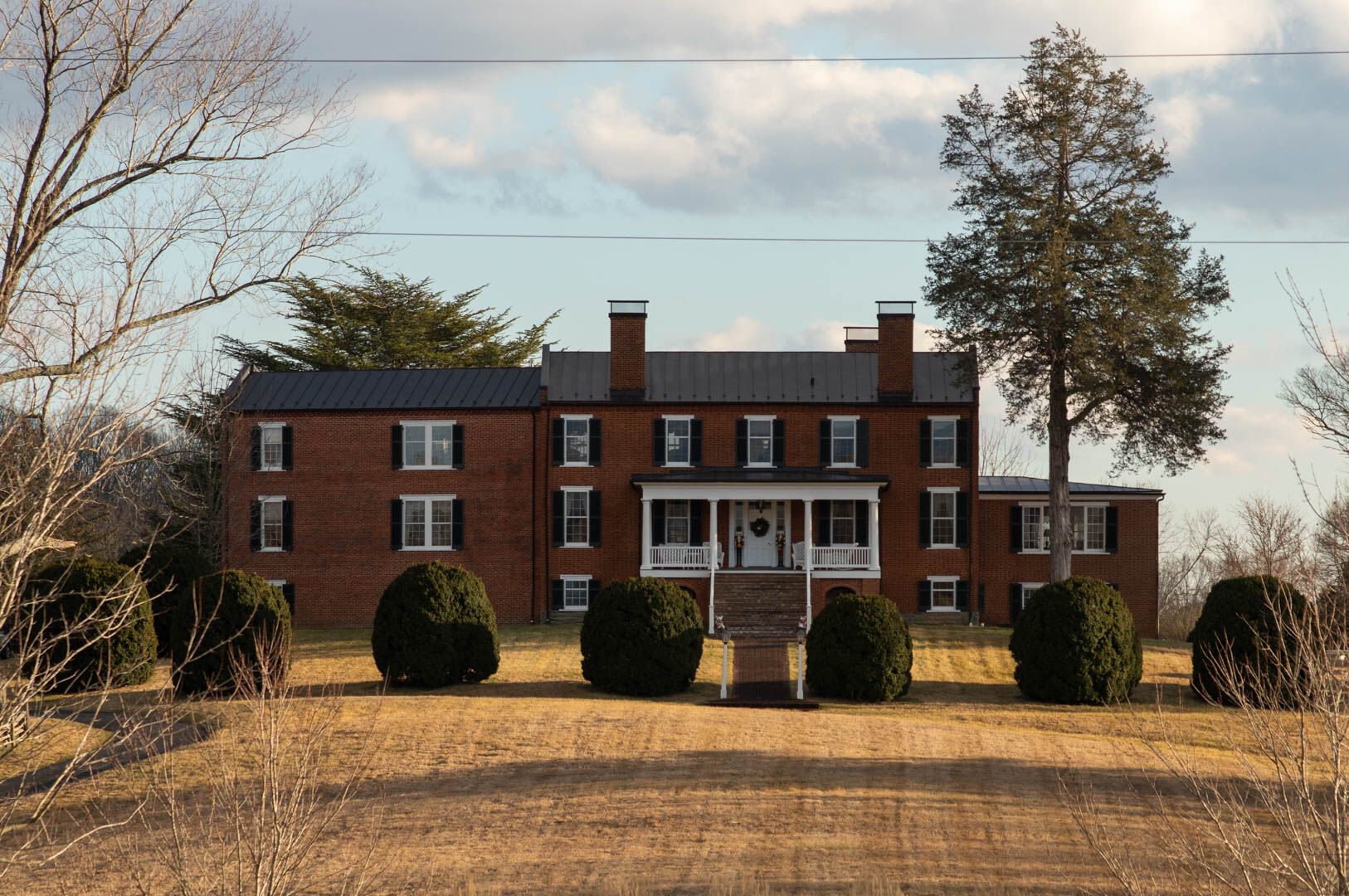‘His heart was always in Rappahannock’
John Anderson was the quintessential local kid who made good, a hometown hero who died on Jan. 31 at the age of 77, after a months-long battle with COVID and its complications.

anderson-6-web.jpg
John Anderson with his first pup, Einstein, a Silky Terrier, at a wedding of one of his daughters at Jessamine Hill.
From Chester Gap to Castleton, his story is the rags-to-riches that everyone loves to tell. Maybe because he looked for the path to make everyone a winner and reached the top without stepping on anyone in the climb. Maybe because his heart was always in Rappahannock, and after he found success, he came back to share, to make life better here, a philanthropist on the public stage but also a quiet Samaritan, privately helping behind the scenes. Maybe because he was proud of how he grew up, saw nothing demeaning in poverty, looked down on no one and showed kindness to all.
For whatever reason, his is one of the favorite chapters in the legends and lore from the morning side of the Blue Ridge.
The beginning: Everyone was poor
Born Feb. 8, 1946, John was one of six children raised in a log cabin at the foot of Mt. Marshall, without indoor plumbing or running water. “We were poor, and we knew we were poor,” recalled his sister Alice Anderson. “But that’s the way it was. We had a wonderful childhood, a happy childhood. Everyone around us was poor. We didn’t stand out, and we never felt deprived.”

anderson_1-web.jpg
John Anderson and his date, Beth Cannon, at Rappahannock County High School’s senior prom in 1964.
The kids worked in the family vegetable garden, tended the livestock, collected wood, hauled water and helped with the rest of farming’s endless tasks. “When we finished our chores, we made our own fun,” Alice said. “We’d play cowboys and Indians and hide and seek, or just run through the pastures. In the winter, with snow on the ground and the moon shining, we’d sled at night in the fields at Quaintance’s Farm. And we rode bikes everywhere.”
One destination was an old bridge where locals stopped to toss trash in the days before dumpsters. The bikers scavenged there. Returnable beer bottles brought three cents, coke bottles two cents.
“If we had five cents, we go home with a pack of gum, 10 cents and we might get a little cake,” recalled Diane Bruce, John’s best friend in grade school and junior high. “Joined at the hip,” is how sister Alice described the pair. They rode bikes together, played basketball together, did homework together and just hung out together.
“I can’t imagine a better friend than John Anderson,” said Bruce, Rappahannock’s long-time former clerk of the Circuit Court. “He started with nothing, he gained everything on his own through hard work, and then he was willing to give it away.”
Typing toward the future
In 1964, 18-year-old John Anderson graduated from Rappahannock County High School. When choosing classes — he hadn’t been encouraged to take college prep courses – no one expected the poor boy from a poor family to go that far.
But he had “strong influences,” said Alice, in teacher Pauline Bruce, in Lois Snead whose husband, Raynor Snead, was the Circuit Court judge, in Social Services manager Betty Buntin and in Episcopal minister John Frizzel, who enlisted John in Trinity’s new youth group open to all denominations. His mentors pointed him to career possibilities beyond the county line, and John left with his high school diploma for a Grade 2 clerk typist job at the Interstate Commerce Commission.
At night, he earned an accounting degree from Benjamin Franklin University (especially adapted to working students with full-time day jobs), worked nights at Sears and then to night school at the University of Virginia Extension and George Mason University. In government service, he reached Grade 15, the highest rung on the general services ladder, and in 1980, he was recruited by A. T. Kearney, one of the nation’s most distinguished management consulting firms. Here, his fields included aerospace and defense, automotives, communications and technology, chemicals, healthcare, mining and metals, oil and gas, consumer products and retail, infrastructure, utilities and other industries that power the world’s economy.
“John worked for the largest projects of the largest companies and agencies, on a gigantic scale, like helping the U.S. Postal Service compete logistically with Amazon and UPS, ” said Washington’s former mayor John Fox Sullivan. The two collaborated on local projects ranging from pantries to post offices to affordable housing. “He had a disciplined, logical mind. He believed in doing all the homework possible, collecting data and making decisions based on facts.”
Anderson would often say his talent was “the ability to connect the dots.” He saw himself as a “business psychiatrist,” attributing his success to “passion, persistence, patience and a work ethic.”
It was a good formula for success. He became the century-old consulting firm’s longest-tenured partner at 40 years, before retiring in January 2022.
While he was “down country,” working his way to financial security, Anderson returned regularly to Rappahannock to visit his parents and his sister Alice, insisting his blood pressure would drop by 20 points when he saw Warrenton in the rear-view mirror. He always intended to make his home here again. His family, his beautiful county and its wonderful people — those were his greatest loves.
In 1998, he bought Jessamine Hill Farm and began a 16-year project to restore the 200-year-old brick manor house to elegance. “It was never about his ego,” said Jennings Hobson, John’s friend and former pastor at Trinity Episcopal Church. “He wanted to give back to his community.”
“He loved Jessamine Hill, but most of all, he loved sharing it with his community,” John’s sister affirmed.

anderson_5-web.jpg
John Anderson’s first car with Diane Bruce perched in it in front of the Bruce’s family home.
Over the years, he opened his home for fundraising including gatherings for the Rappahannock County Garden Club, Trinity Episcopal Church and the Food Pantry. But first he hauled away rubbish, pruned shrubbery and trees, bush hogged and downed the dead and dying giant elms lining the mile-long driveway. He found expert craftsmen locally, the perfect farm manager and handyman in his second cousin, and a self-taught landscaping whiz and garden planner in sister Alice, who restored and now maintains the grounds.
In between management consulting at A.T. Kearney and project managing at Jessamine Hill, Anderson turned interior designer, combining business trips with short shopping expeditions to find furnishings for the manor house in places like the markets of Paris.
Alice remembers how much her brother enjoyed showing off his rescue project. But it was the county itself that gave him the most pride. She recalls John regularly pausing on countless drives here and there, as they’d crest a hill to another soul-stirring vista. “So many times, he’d turn to me and ask, ‘Alice, do you know how lucky we are to be living in Rappahannock County?’”
And Rappahannock was lucky to count John Anderson among its people.

Anderson_7_John-Anderson-chats-on-front-porch-(1)-4-10-05-web.jpg
John Anderson on the porch at Jessamine Hill.
Admiring friends may not completely agree on how John would want to be remembered, but they are in total accord on the man and his character.
“John was kind and so welcoming,” said Mimi Forbes, the first manager of the Food Pantry who worked with Anderson on a capital campaign, two benefit dinners and countless smaller initiatives during her 14 years as manager.
“He was such a great talker and storyteller. He told tales from Rappahannock’s past and his travels worldwide, and every time, a listening circle would gather around him. The welcome, the kindness, his interest in others and his stories — those attributes made John the consummate host.” He gave great attention to detail, Forbes added. “Arrive early at Jessamine Hill for an event, and you were likely to catch him mowing the front lawn himself!”
“We have lots of home-grown success stories but none has the bandwidth of John’s story,” Jimmie DeBergh said. A long-time resident of Harris Hollow, his family’s farm bordered the Anderson property, and the kids grew up together. “John really did love this county and what it did for him on his life journey. And he gave back. He took care of people. He took care of his family. He was an excellent strategist at fundraising, and he actively gave money himself. He was energy, and he’s responsible for hundreds of thousands of dollars for Rappahannock.”
Navigating back channels to success
DeBergh and Anderson were part of a group tackling affordable housing in Rappahannock. “John was also an excellent strategist,” DeBergh said. “He knew the back channels and how to navigate them, and who to call. If you had John on your team, you had a great chance of success.”
Anderson used those back channels and connections to convince the director of the U.S. Postal Service that the new post office for the town of Washington belonged in the town, thereby preserving community-building bricks and a magnet for drawing in people. Anderson never took credit for the director’s reversal, which he engineered. That, too, was his modus operandi. Modest, humble, genuine – those words were often repeated in descriptions of John Anderson.
“John didn’t just invest in financial endeavors, he invested in people“ affirmed Mary Ann Kuhn, senior editor at the Rappahannock News and former owner/manager of the Middleton Inn. “He gave unconditional support, friendship and encouragement.”
Anderson would call to brainstorm ways to build the elusive mid-week traffic and share ideas on how local businesses could cooperate to achieve that goal. “We’d talk and talk. Well, actually, I listened and John talked!” Midweek could be dead, Kuhn continued, and then, out of the blue, would come a reservation to bring the top people from A.T. Kearney out for a conference, staying at Middleton Inn and conferencing there, dining at The Inn at Little Washington, shopping in the town, hiking in Shenandoah National Park and otherwise promoting local enterprises.
“I always felt John and his sister Alice had my back. There’s an emptiness with him gone,” she said. “The whole county feels it.”
Building bridges to ‘One Rappahannock’
An overarching goal for Anderson was to bridge the divide in Rappahannock between “been-here” and “come here,” said John Sullivan. He and Anderson were co-chairs of the capital campaign that has raised $600,000 and counting for the pantry’s new home now under construction in the town of Washington. Anderson viewed that project as building material for the bridge.

John Sullivan and John Anderson
John Sullivan and John Anderson discuss the “One Rappahannock” campaign to benefit the Food Pantry in May 2019.
“‘One Rappahannock’ – the theme for the pantry’s capital campaign – that was John’s idea,” added Noel Laing, the nonprofit’s former president. “John saw the pantry as being for everybody, not just for the poor. His message was whether you are a shopper or a supporter, it is YOUR pantry, so pull together and give people what they need.”
Anderson envisioned a Rappahannock that was both caring and cohesive. With the pantry, he saw a means for newcomers and longtimers to work together for something bigger than themselves, to know and appreciate each other while cooperating on behalf of the county they cherished and the people who made it home.
Pantry ambassadors in Rappahannock’s villages and hamlets were tapped to organize their neighborhoods to raise money in their own way. So, Sullivan noted as examples, Bubby Settle held a fish fry at Settle’s Garage in Flint Hill while groups of like-minded pantry-supporting friends hosted dinner party fundraisers in the hollows and the hills. “Get the facts, use commonsense, work together and get the job done – that was John,” said Sullivan.
While Anderson was dedicated to raising money for the panty, he wanted more than just the usual wealthy sources. He wanted financial contributions from ordinary people, Sullivan noted, a broad base of support that included every segment of society here. That, too, would help build the bridge.
To provide the opportunity to give in smaller, affordable ways, change boxes for donations were scattered in the county’s country stores at the start of the capital campaign. To date, over $10,000 has been collected from those boxes.
Working to the end for his county
As evidence of his boundless drive, optimism and commitment, when Anderson was hospitalized with severe COVID in early January, he was still expecting to hold the Food Pantry’s annual benefit gala at Jessamine Hill, his third time hosting the nonprofit’s most important fundraiser. Two weeks later, on life support but still awake and alert, he continued to invite new faces – doctors, nurses, aides and orderlies – to the grand opening of the pantry’s permanent home in the town of Washington, coming in late spring.
As to what Anderson would most want to be remembered for, many of his friends spoke of his kindness and generosity. One or two named the restoration of Jessamine Hill into a treasure shared with his community. None cited Anderson’s Horatio Alger story or his success at gaining wealth, property and influence.

Anderson_8_1920-web.jpg
John Anderson’s 16-year restoration project, Jessamine Hill, built between 1825 and 1830, was the home of Thomas Fletcher and his wife, Susan Stack Fletcher. Fate may have intended it to be Anderson’s one day. When he was clearing the Fletcher family graveyard, he found the headstone of John Kinsey Fletcher, his namesake, and it’s where he is to be buried, right behind the first John Kinsey. And the ashes of Anderson’s first dog, Einstein, will be buried with him.
Noel Laing might have come closest to seeing what was in his heart: “I think John was proudest of what he did for the Food Pantry, and the way the whole county got behind the fundraising campaign for its new home.”
After all, that is John Anderson’s dream. One Rappahannock.









